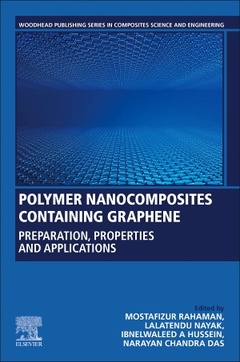Polymer Nanocomposites Containing Graphene Preparation, Properties, and Applications Woodhead Publishing Series in Composites Science and Engineering Series
Coordonnateurs : Rahaman Mostafizur, Nayak Lalatendu, Hussein Ibnelwaleed A., Das Narayan Chandra

Polymer Nanocomposites Containing Graphene: Preparation, Properties and Applications provides detailed up-to-date information on the characterization, synthesis, processing, properties and application of these materials. Key topics that are covered in the book include: the methods of synthesis and preparation of graphene as well as different processes and methods of functionalization and modification of graphene for improving composite properties. The preparation techniques focus on which method is advantageous for getting improvements in properties along with their drawbacks. The structure and property relationships are also discussed in detail. The issues related to graphene dispersion in polymer matrices is also addressed as well as the use of graphene as reinforcement in thermoset resins. The different properties of the composites like mechanical, electrical, dielectric, thermal, rheological, morphology, spectroscopy, electronic, optical, and toxicity are reviewed from the geometrical and functional point of view. Applications cover electrical and electronic fields, flame and fire retardancy, structural, sensing and catalysis, membrane, in fuel cell and solar energy, hydrogen production, aerospace engineering, packaging, and biomedical/bioengineering fields. Up-to-date patents on graphene-polymer nanocomposites are also covered. Those working in graphene-based materials will benefit from the detailed knowledge presented in this book on graphene synthesis, composite preparation methods, and the related problems associated with them. The book will enable researchers to select the appropriate composite as per their respective field of application.
Part I: Preparation and Properties of Polymer Graphene Composites 1. Synthesis/Preparation and Surface Modification/Functionalization of Graphene, and Concept of Nanocomposites 2. Preparation/Processing of Polymer Graphene Composites by Different Techniques 3. Mechanical Properties of Polymer Graphene Composites 4. Electrical Conductivity of Polymer Graphene Composites 5. Dielectric Properties of Polymer Graphene Composites 6. Thermal Properties of Polymer Graphene Composites 7. Rheological Properties of Polymer Graphene Composites 8. Electromagnetic Interference Shielding Property of Polymer Graphene Composites 9. Thermal Conductivity of Polymer Graphene Composites 10. Dispersion of Graphene in Polymer Matrices 11. Structure-property Relationship in Polymer-graphene Composites 12. Graphene as a Reinforcement in Thermoset Resins
Part II: Applications of Polymer Graphene Composites 13. Electrical and Electronic Application of Polymer-Graphene Composites 14. Structural/Load Bearing Characteristics of Polymer Graphene Composites 15. Polymer-Graphene Composites as Sensing Materials 16. The Use of Polymer-Graphene Composites in Fuel Cell and Solar Energy 17. Biomedical Application of Polymer Graphene Composites 18. The Use of Polymer-Graphene Composites in Catalysis 19. The Use of Polymer-Graphene Composites as Membrane 20. Polymer-Graphene Composites as Anti-corrosive Materials 21. Patents on Graphene Based Polymer Composites and Their Applications 22. Polymer-Graphene Composite in Hydrogen Production 23. Polymer-Graphene Composite in Aerospace Engineering 24. Packaging Applications of Polymer- Graphene Composites 25. Polymer- Graphene Composites as Flame and Fire Retardant Materials
Dr. Lalatendu Nayak is a Principal Scientist at Phillips Carbon Black’s Global Research and Development Centre, Palej, Gujarat, India. He completed his PhD (Polymer) from Indian Institute of Technology, Kharagpur, West Bengal, India, M Tech (Polymer) from Central Institute of Plastics Engineering and Technology, Bhubaneswar, Odisha, India, and M.Sc. (Organic Chemistry) from Fakir Mohon University, Odisha, India. He has published more than 20 research articles in different international journal and published two book chapters. He is an active reviewer in different international journals. He has more than 10 years research experience in the field of conductive polymer composites and nanocomposites, synthesis and surface treatment of nanomaterials
Dr. Hussein is a Research Professor at the Gas Processing Center, Qatar University. He was a former Professor of Chemical Engineering and a former Assistant Director of the Center of Research Excellence in Petroleum Refining and Petrochemicals at KFUPM, Saudi Arabia. Dr. Hussein obt
- Presents novel approaches for the preparation of graphene, its modification and nanocomposites with enhanced properties for state-of-the-art applications
- Special attention is given to how graphene is synthesized through different routes, their functionality, dispersion related matters and structural aspects controlling the composite properties for various applications
- All synthesis methodology and functionalization procedure for graphene is discussed
Date de parution : 08-2021
Ouvrage de 816 p.
15.2x22.8 cm
Thème de Polymer Nanocomposites Containing Graphene :
Mots-clés :
?Aerospace application; Agglomeration; Anticorrosive coating; Applications; Barrier properties; Biocompatible; Biodegradable; Biomedical; Catalytic hydrogenation; Composite; Composites; Degradation; Dielectric; Dispersion; EMI shielding; Elastomer; Electrical; Electrical conductivity; Electrocatalytic activity; Electrochemical sensors; Electronics packaging; Energy; Exfoliation; Expandable graphite; Fabrication; Fiber; Filler loading; Filtration; Food packaging; Fuel cell; Functionalization; Graphene; Graphene nanocomposites; Graphene oxide; Graphene oxides; Graphene polymer composite; Graphene-based polymer composite; Graphenes; Homogeneity; Hydrogen production; Interaction; Intercalation; Inventions; Lithium-air battery; Mechanical properties; Membrane; Metal corrosion; Microstructure; Miniaturization; Models; Morphology; Multifunctional sensor; Nanocomposite; Nanocomposites; Nanofiller; Nanomaterials; PH-responsive sensor; Patents; Percolation threshold; Photocatalytic activity; Polymer; Polymer composite; Polymer composites; Polymer matrix; Polymer nanocomposites; Polymer-graphene nanocomposites; Polymers; Properties; Reduced graphene oxide; Reinforcing mechanism; Residue; Resin; Rheological percolation; Rheology; Sensor classification; Sensors; Separation; Solar cell; Strain sensors; Structural materials; Structure-property; Supercapacitors; Synergistically; Synthesis; TGA; Thermal conduction model; Thermal conductivity; Thermal stability; Thermoresponsive sensors; UL-94 FR rating



